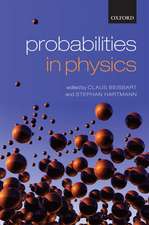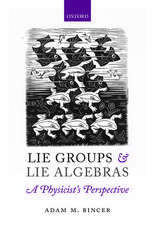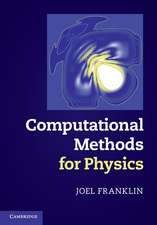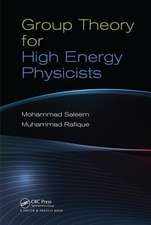Groups, Systems and Many-Body Physics: Vieweg tracts in pure and applied physics, cartea 4
Autor Peter Dal Cinen Limba Engleză Paperback – 31 dec 1979
Preț: 399.50 lei
Nou
Puncte Express: 599
Preț estimativ în valută:
76.44€ • 83.30$ • 64.42£
76.44€ • 83.30$ • 64.42£
Carte tipărită la comandă
Livrare economică 23 aprilie-07 mai
Preluare comenzi: 021 569.72.76
Specificații
ISBN-13: 9783528084448
ISBN-10: 3528084448
Pagini: 432
Ilustrații: XVI, 412 p.
Dimensiuni: 170 x 244 x 23 mm
Greutate: 0.69 kg
Ediția:Softcover reprint of the original 1st ed. 1980
Editura: Vieweg+Teubner Verlag
Colecția Vieweg+Teubner Verlag
Seria Vieweg tracts in pure and applied physics
Locul publicării:Wiesbaden, Germany
ISBN-10: 3528084448
Pagini: 432
Ilustrații: XVI, 412 p.
Dimensiuni: 170 x 244 x 23 mm
Greutate: 0.69 kg
Ediția:Softcover reprint of the original 1st ed. 1980
Editura: Vieweg+Teubner Verlag
Colecția Vieweg+Teubner Verlag
Seria Vieweg tracts in pure and applied physics
Locul publicării:Wiesbaden, Germany
Public țintă
ResearchDescriere
The authors of the present book share the view that groups and semigroups playa funda mental role in the structure of the complex systems which they are studying. A serious effort was made to implement this point of view by presenting the fundamental concepts pertaining to groups and semigroups before going into the various fields of application. The first two chapters are written in this spirit. The following seven chapters deal with groups in relation to specific systems and lead from basic notions to high-level applications. The systems under study are in all cases characterized by a high degree of complexity as found in the physics of many degrees of freedom and in the theory of automata and systems. In 1977 the authors from the University of Tiibingen (M. Dal Cin, G. John, P. Kramer, A. Rieckers, K. Scheerer and H. Stumpf) organized an International Summer School on Groups and Many-Body Physics. The lectures presented at this School dealt specifically with this interplay of groups and complex systems. The contributions of this book cover the fields which were treated in a condensed form at the Summer School.
Cuprins
I Fundamentals on Semigroups, Groups and Representations.- 1 Groups and group action.- 1.1 Preliminaries.- 1.2 Algebraic composition, semigroups and groups.- 1.3 Transformation groups.- 2 Examples of groups.- 2.1 The symmetric group S(n).- 2.2 Matrix semi-groups and inner products.- 2.3 Inhomogeneous matrix groups.- 3 Subgroup structures of groups and semigroups.- 3.1 Preliminaries: complexes and lattices.- 3.2 Subgroup diagrams.- 3.3 Morphisms and subgroups.- 3.4 Direct and semidirect products.- 3.5 Subnormal chains.- 3.6 Subgroups of semigroups.- 4 Groups and topology.- 4.1 Topological groups.- 4.2 Lie groups.- 4.3 Invariant measures.- 5 Representations of groups.- 5.1 General properties of representations.- 5.2 Irreducible representations of the symmetric group.- 5.3 Finite irreducible representations of the general linear group.- 5.4 Group algebras and representations.- 5.5 Induced and subduced representations.- 6 Induced representations of the Poincaré group.- 6.1 Poincaré transformations.- 6.2 Representations.- 6.3 Induced representations.- 6.4 UIR’s of the Poincaré group.- 6.5 The Dirac equation.- References.- II Fundamentals of Algebraic Quantum Theory.- 1 Algebra of observables.- 2 States.- 3 Symmetry transformations.- 4 Represented systems and symmetries.- 5 Dynamical symmetries and equilibrium states.- Appendix: Jordan homomorphisms.- References.- III Pauli Principle and Indirect Exchange Phenomena in Molecules and Solids.- 1 Permutation symmetry and chemical bonding in molecules and solids.- 1.1 Permutation symmetry and exchange interactions.- 1.2 Exchange interactions and chemical bonding.- 1.3 The Heisenberg (effective spin-) Hamiltonian approach to exchange interactions.- References.- 2 Group-theoretical aspects pertaining to the quantum-mechanical N-particle system.- 2.1 Introduction.- 2.1.1 Hamilton operator and Hilbert space.- 2.1.2 Symmetry and Wigner’s theorem. The irreducibility postulate, the identity postulate and the Pauli postulate.- 2.1.3 The spin free Pauli principle.- Appendix A The Schur-Weyl theorem.- Electrbn spin and permutation symmetry.- 2.2 Symmetry adaptation.- 2.2.1 Matric bases.- 2.2.2 Some fundamental expressions pertaining to matric bases.- 2.2.3 Some special choices of matric bases, G = SN.- 2.2.4 Symmetry adaptation of Vn ?N to SN.- 2.2.5 Antisymmetrization.- Appendix B Sequence adaption. Double coset decomposition of unitary matric bases.- Appendix C Tableau operators.- Invariance groups for tableaux operators.- 2.3 Matrix elements and their evaluation.- 2.3.1 Introduction.- 2.3.2 Matrix elements over Young-Yamanouchi N-electron spin (S, M) eigenfunctions.- 2.3.3 Matrix elements of a spin-free observable over sequence-symmetryadapted bases.- 2.3.4 Matrix elements of the spin-free N-electron Hamilton operator over Young unil-type Y?-projected N-electron bases. Pauling numbers.- 2.3.5 Summary and Discussion.- Appendix D The triple double coset symbol, double cosets, DC.- References.- Appendix E The canonical double coset symbol.- References.- Appendix F General references.- Appendix G Special references.- 3 The effective electron model: Applications.- 3.1 Introduction.- 3.2 Effective-electron model for weak chemical bonding.- 3.3 Applications of the model.- 3.3.1 Indirect exchange interactions in magnetic solids.- 3.3.2 Stability of rare-gas halides: A case of selective valence.- 3.3.3 Rotational barriers in simple molecules.- 3.3.4 Magnetic structures of the manganese pyrites.- References.- IV Groups and Semigroups for Composite Nucleon Systems.- 1 Introduction.- 2 Exchange and double cosets of the symmetric group.- 3 Orbital symmetry and the representation of the symmetric and general linear groups.- 4 Weyl operators, linear canonical transformations and Bargmann Hilbert space.- 5 Canonical transformations for interacting n-body systems.- 6 Interaction of composite particles.- 7 Configurations of simple composite particles.- 8 Composite particles with a closed-shell configuration.- 9 Conclusion.- References.- V An Algebraic Approach for Spontaneous Symmetry Breaking in Quantum Statistical Mechanics.- 1 Introduction.- 2 General theory.- 2.1 Finite statistical mechanics.- 2.2 Thermodynamical limit.- 2.3 KMS and thermodynamical stability.- 2.4 Properties of KMS states.- 2.5 What is a pure thermodynamical phase?.- 2.6 Cluster properties and ergodic theory.- 2.7 Uniform clustering.- 2.8 Symmetry-breaking and decomposition theory.- 3 Exactly solvable models.- 3.1 The BCS model.- 3.2 The Weiss-Ising (anti-) ferromagnet.- 3.3 Ising and Heisenberg models.- 3.4 Conclusion.- 4 Existence of crystals.- 4.1 A general theory.- 4.2 Physical interpretation.- 4.3 Related theories.- References.- VI Dynamical Groups for the Motion of Relativistic Composite Systems.- 1 Introduction.- 2 The general framework.- 3 Composite systems and reducible representations.- 4 The method of induced representations from dynamical groups.- 5 Electron-positron complex.- 6 Composite systems. Inductive approach.- 7 Dynamical algebras, their contraction and generalizations.- 8 Passage to relativistic wave equations.- 9 Principles on the choice of infinite component wave equations.- 10 The Majorana “particle”.- 11 An inverse problem.- 12 The class of composite systems based on conformal group.- 13 Electromagnetric interactions of composite systems.- 14 Other interactions of composite systems.- 15 A characteristic property of relativistic composite systems: Space-like states.- Appendix A: List of unitary irreducible representations of % MathType!MTEF!2!1!+-% feaagCart1ev2aqatCvAUfeBSjuyZL2yd9gzLbvyNv2CaerbuLwBLn% hiov2DGi1BTfMBaeXatLxBI9gBaerbd9wDYLwzYbItLDharqqtubsr% 4rNCHbGeaGqiVu0Je9sqqrpepC0xbbL8F4rqqrFfpeea0xe9Lq-Jc9% vqaqpepm0xbba9pwe9Q8fs0-yqaqpepae9pg0FirpepeKkFr0xfr-x% fr-xb9adbaqaaeGaciGaaiaabeqaamaabaabaaGcbaWaa0aaaeaaca% WGtbGaam4tamaabmaabaGaaGOmaiaacYcacaaIXaaacaGLOaGaayzk% aaaaaiablYJi6maanaaabaGaam4uaiaadwfadaqadaqaaiaaigdaca% GGSaGaaGymaaGaayjkaiaawMcaaaaaaaa!41FD!$$\overline {SO\left( {2,1} \right)} \sim \overline {SU\left( {1,1} \right)} $$.- Appendix B: List of most degenerate unitary irreducible representations of SO (4, 2).- References.- VII New Representation Spaces of the Poincaré Group and Functional Quantum Theory.- 1 Quantum theoretical fundamentals.- 2 Poincaré group representations in field theory.- 3 Functional map.- 4 Functional calculation methods.- 5 Noncanonical quantization and unitarization.- References.- VIII The Algebraic Theory of Automata.- 1 Systems, automata and switching networks.- 1.1 Input-output systems.- 1.2 Automata.- 1.3 Sequential switching networks.- 2 Transformation monoids and cascades.- 2.1 Simulation of automata and covering of transformation monoids.- 2.2 Cascades and wreath products.- 3 Structures of finite automata.- 3.1 Simulation of group automata.- 3.2 Examples.- 3.3 The Krohn-Rhodes-Eilenberg decomposition of finite automata.- 3.4 Realizations of group automata.- References.- IX On the (Internal) Symmetry Groups of Linear Dynamical Systems.- 1 Introduction and statement of the main definitions and results.- 2 Complete Teachability and complete observability.- 3 Nice selections and the local structure of Lm,n,pcr/GLn(IR).- 4 Realization theory.- 5 Feedback splits the external description degeneracy.- 6 Description of Lm,n,pco,cr(IR)/GLn(IR). Invariants.- 7 On the (non-)existence of canonical forms.- 8 On the geometry of Mm,n,pco,cr(IR). Holes and (partial) compactifications.- References.















